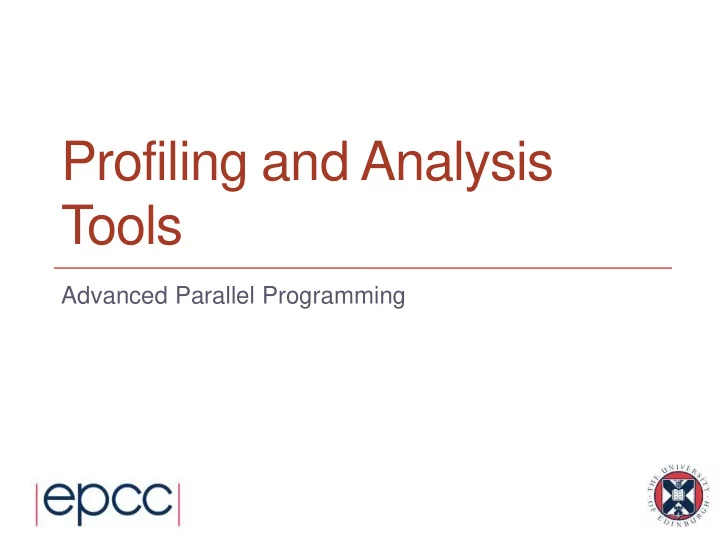

Profiling and Analysis Tools Advanced Parallel Programming
WHAT’S THE PROBLEM? Why do we need tools?
Reminder Techniques for finding performance problems in a large code: • Manual investigation, looking at the code and machine • Benchmarking, running and timing the code on a machine • Profiling tools, sampling and tracing the code on a machine • Analysis tools, auto-magic wizardry 3
Simple machine schematic • https://computing.llnl.gov/tutorials/ibm_sp/ 4
https://image.slidesharecdn.com/ccgrid11ibhselast-160218070646/95/designing-cloud- and-grid-computing-systems-with-infiniband-and-highspeed-ethernet-39-638.jpg 5
Intel E2607 v3 schematic http://www.anandtech.com/show/8584/intel-xeon-e5-2687w-v3-and-e5-2650-v3-review- haswell-ep-with-10-cores 6
Node hardware https://www.open-mpi.org/projects/hwloc/ 7
Network tolopogy Fat tree topology Dragonfly topology https://slurm.schedmd.com/topology.html http://www.nersc.gov/users/computational- systems/edison/configuration/interconnect/ 8
Some useful links • Information about ARCHER hardware layout: - http://www.archer.ac.uk/about-archer/hardware/ • Intel ‘ark’ information for an example processor: - http://ark.intel.com/products/75283/Intel-Xeon-Processor-E5-2697-v2- 30M-Cache-2_70-GHz • Information about Cirrus hardware: - http://cirrus.readthedocs.io/en/latest/hardware.html - https://www.sgi.com/products/servers/ice/ice_xa.html 9
WHY DOES THIS MATTER? OK, hardware is complicated – so what?
Task mapping • On most systems, the time taken to send a message between two processors depends on their location on the interconnect. • Latency depends on number of hops between processors • Bandwidth might vary between different pairs of processors • In an SMP cluster, communication is normally faster (lower latency and higher bandwidth) inside a node (using shared memory) than between nodes (using the network) 11
• Communication latency often behaves as a fixed cost + term proportional to number of hops. 12
• The mapping of MPI tasks to processors can have an effect on performance • Want to have tasks which communicate with each other a lot close together in the interconnect. • No portable mechanism for arranging the mapping. - e.g. on Cray XE/XC supply options to aprun • Can be done (semi-)automatically: - run the code and measure how much communication is done between all pairs of tasks - tools can help here - find a near optimal mapping to minimise communication costs 13
• On systems with no ability to change the mapping, we can achieve the same effect by create communicators appropriately. - assuming we know how MPI_COMM_WORLD is mapped • MPI_CART_CREATE has a reorder argument - if set to true, allows the implementation to reorder the task to give a sensible mapping for nearest-neighbour communication - unfortunately many implementations do nothing, or do strange, non- optimal re-orderings! • … or use MPI_COMM_SPLIT 14
Custom cluster – no tools • Basic requirement to ‘pin’ processes/threads - Set a “CPU mask” or similar operating system function call - Restrict each application thread to a single physical core • Always possible to schedule one process/thread per core - Ensure different runtimes play well together (current research topic) - Use as many (or as few) processes as you want - Get machine topology by measuring communication performance - Chose which processes to use, e.g. based on physical location • Analysis is mostly guesswork with trial and error - Create a small (short time to completion) representative test-case - Try to be systematic and cover the available parameter space - Keep good records of your tests and the results • OR install and use tools 15
WHAT TOOLS ARE THERE? What can tools do?
Uses for debugging tools • Where did my program crash? - Obtain a stack trace at the point of failure - Examine ‘core’ file using gdb (or similar) - Use a debugger tool, e.g. Allinea DDT, many others • Where are the memory leaks in my program? - Use ‘ valgrind ’ • Why does my program get the wrong answer? - Use ‘ printf ’/’write’ statements to verify variable values - Use an interactive debug tool to step through code, e.g. DDT/others 17
Uses for performance tools • Change process placement to optimise communication - Discover and map hardware topology, e.g. hwloc - Specify rank mapping, e.g. ‘ aprun ’ settings or MPI communicators • Discover ‘hot - spots’ – code that takes up most runtime - Identify areas most in need of (greatest impact from) optimisation - Profiling tools, trace first, then selectively instrument - CrayPAT, Allinea MAP, Scalasca, Intel vTune, TAU, many others • Discover sub-optimal use of CPU/memory components - Access hardware counters, e.g. Performance API (PAPI) - Re-order calculation/communication, i.e. algorithm code changes • Discover sub-optimal communication patterns - Infer the problem from other performance evidence, plus intuition - Alter calculation/communication, i.e. algorithm code changes 18
What tools are available? • Tools on ARCHER: - http://www.archer.ac.uk/about-archer/software/ - “Debugging Tools – DDT, Cray ATP, GDB” - “Profiling Tools – CrayPAT ” • Tools on Cirrus: - Intel vTune (discovered by doing “module avail”) • A survey of tools on another machine (Aurora): - http://www.paradyn.org/petascale2015/slides/2015_0804_scalableTools _rashawn_knapp_presentation_final.pdf 19
20
Summary • Tools can do *anything* the tool developer can dream up • There are some well-known tools and many less well-known • But no standard set of tools that will be available everywhere • Find out what tools are available on systems you can access • Read the documentation for each system • Investigate on the machine itself, e.g. ‘module avail’ • Use tools that are already installed, e.g. by sys admin team • OR download and install additional tools yourself 21
Recommend
More recommend